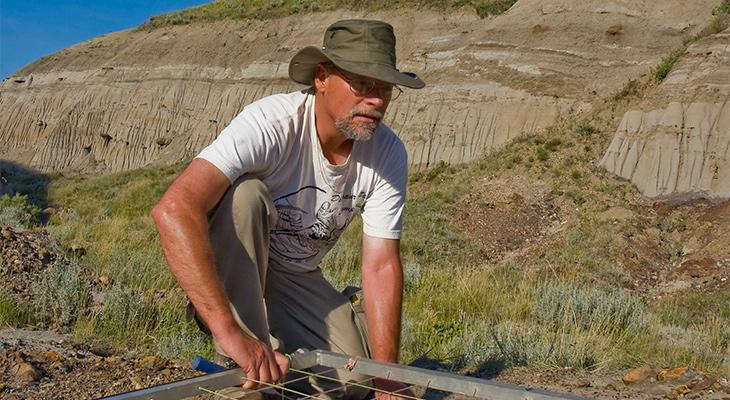David (Dave) Eberth studies the ancient environments of fossil-bearing rocks, and how changing environments influenced vertebrate palaeoecology and evolution. His research focus is stratigraphy and sedimentology. Dave also studies bonebeds-accumulations of fossils from more than one individual. Studying bonebeds shows us what the Earth's ancient environments were like, and how they changed through time, giving us insights into what the future may hold.
Research Interests
- Stratigraphy (the order and position of strata and their relationship to the geological time scale).
- Sedimentology (the study of modern sediments and the processes that result in their formation).
- Chronostratigraphy (the age of rocks).
- Taphonomy (the study of influences on preservation and fossilization).
- The influence of changing environments and climate on vertebrate palaeoecology and evolution.
- The evolution of dinosaur ecosystems worldwide.
- Improving the resolution of radioisotopic dating.
- Bonebeds.
Professional Highlights
- Documented complex changes in palaeoenvironments and climates that characterized the last 10 million years of the Age of Dinosaurs in Alberta.
- Presented the first high-precision absolute (radiometric) dates for dinosaurs in Alberta.
- Documented the importance of dinosaur bonebed studies, with specific reference to the impacts of ancient tropical storms on dinosaur mortality and preservation in western Canada.
- Conducted the first palaeo-environmental studies of Late Cretaceous dinosaur assemblages in northern China and southern Mongolia.
Education
Ph.D., University of Toronto, 1987
M.A., University of California, 1981
B.Sc., University of Massachusetts, 1977

- Recent Publications
Eberth, D. A. (2017). Stratigraphy and paleoenvironmental evolution of the dinosaur-rich Baruungoyot-Nemegt succession (Upper Cretaceous), Nemegt Basin, southern Mongolia. Palaeogeography, Palaeoclimatology, Palaeoecology. https://doi.org/10.1016/j.palaeo.2017.11.018
Eberth, D. A. (2015). Origins of dinosaur bonebeds in the Cretaceous of Alberta. Canadian Journal of Earth Sciences, 52(8), 655-681.
Evans, D. C., Eberth, D. A. & Ryan, M. J. (2015). Hadrosaurid (Edmontosaurus) bonebeds from the Horseshoe Canyon Formation (Horsethief Member) at Drumheller, Alberta, Canada: Geology, preliminary taphonomy, and significance. Canadian Journal of Earth Sciences, 52(8), 642-654.
Eberle, J. J. & Eberth, D. A. (2015). Additions to the Eocene Perissodactyla of the Margaret Formation, Eureka Sound Group, Ellesmere Island, Arctic Canada. Canadian Journal of Earth Sciences, 52(2), 123-133.
Eberth, D. A., & Bell, P. R. (2014). Stratigraphy of the Danek Bonebed (Upper Cretaceous Horseshoe Canyon Formation, central Alberta) and correlations with strata in the Drumheller and Grande Prairie regions. Canadian Journal of Earth Sciences, 51(11), 975-981.
